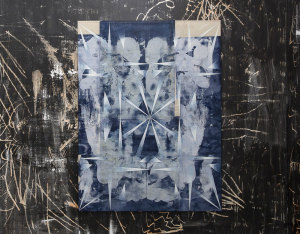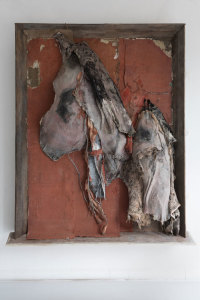ART NEWS:Dec.02
From the paintings and sculptural objects in Tillman Kaiser’s exhibition “Non É Ancora Illegale”, kaleidoscopic patterns emerge out of repetitive crystalline and geometrical shapes.  The complexity of the manifestations are reinforced by Kaiser’s working method, merging media such as painting and photography (including photograms or cyanotypes) and silkscreen in his paintings. In this way he combines techniques based on preparation and planning, and not generally associated with spontaneous expression, with the medium of painting which promises immediacy, spontaneity and expression through the artist’s gesture and immediate treatment of the canvas. Kaiser plays with this ambiguity on various levels, allowing plan and coincidence, conception and improvisation to encounter one another in his works. The view of the world through a kaleidoscope simultaneously distorts it and emphasizes its complexity. Mistrust of simple explanations and pleasure in the diversity of the visible world can be seen as the basic attitude behind the artist’s work. Info: Galerie Emanuel Layr, Via dei Salumi 3, Rome, Duration: 6/12/18-26/1/19, Days & Hours: Tue-Sat 11:00-19:00, www.emanuellayr.com
The complexity of the manifestations are reinforced by Kaiser’s working method, merging media such as painting and photography (including photograms or cyanotypes) and silkscreen in his paintings. In this way he combines techniques based on preparation and planning, and not generally associated with spontaneous expression, with the medium of painting which promises immediacy, spontaneity and expression through the artist’s gesture and immediate treatment of the canvas. Kaiser plays with this ambiguity on various levels, allowing plan and coincidence, conception and improvisation to encounter one another in his works. The view of the world through a kaleidoscope simultaneously distorts it and emphasizes its complexity. Mistrust of simple explanations and pleasure in the diversity of the visible world can be seen as the basic attitude behind the artist’s work. Info: Galerie Emanuel Layr, Via dei Salumi 3, Rome, Duration: 6/12/18-26/1/19, Days & Hours: Tue-Sat 11:00-19:00, www.emanuellayr.com
B rlinde De Bruyckere’s most recent work is inspired by the sixteenth-century artefacts known as the “Enclosed Gardens”. The Gardens are small wooden cabinets filled with a profusion of artefacts, ranging from handmade sculptures to flowers and animals in silk, and including wax medallions and fabric-wrapped bone relics. De Bruyckere senses a natural affinity between her work and these wonderful microcosms, which were part of the spiritual world of the sisters of the Hospital of Our Lady in Mechelen, who crafted them with the utmost care and devotion. With her series her exhibition “It almost seemed a lily”, De Bruyckere enters into a dialogue with the seven “Enclosed Gardens of Mechelen”, which are now recognised as masterpieces. She has created monumental wooden frames that house the tender silhouette of a flower, the latter of which is composed of a multitude of materials that can conceal as much as they reveal. The imposing dimensions of the frames contrast with the fragility of their interiors. Info: Museum Hof van Busleyden, Sint-Janstraat 2a, Mechelen, Duration: 15/12/18-12/5/19, Days & Hours: Mon-Tue & Fri-Sun 10:00-17:00, Thu 10:00-22:00, www.hofvanbusleyden.be
rlinde De Bruyckere’s most recent work is inspired by the sixteenth-century artefacts known as the “Enclosed Gardens”. The Gardens are small wooden cabinets filled with a profusion of artefacts, ranging from handmade sculptures to flowers and animals in silk, and including wax medallions and fabric-wrapped bone relics. De Bruyckere senses a natural affinity between her work and these wonderful microcosms, which were part of the spiritual world of the sisters of the Hospital of Our Lady in Mechelen, who crafted them with the utmost care and devotion. With her series her exhibition “It almost seemed a lily”, De Bruyckere enters into a dialogue with the seven “Enclosed Gardens of Mechelen”, which are now recognised as masterpieces. She has created monumental wooden frames that house the tender silhouette of a flower, the latter of which is composed of a multitude of materials that can conceal as much as they reveal. The imposing dimensions of the frames contrast with the fragility of their interiors. Info: Museum Hof van Busleyden, Sint-Janstraat 2a, Mechelen, Duration: 15/12/18-12/5/19, Days & Hours: Mon-Tue & Fri-Sun 10:00-17:00, Thu 10:00-22:00, www.hofvanbusleyden.be
 Liliane Lijn’s performance “Power Game” is presented in the context of her exhibition “Cosmic Dramas”. First presented in 1974, in the context of the International Festival for Democracy in Chile, at the Royal College of Art, London, Power Game is a collective performance staging a live representation of fantasies of power. Participants who are invited to play the game sit around the gambling table rivaling each other in a rhetoric and intellectual challenge to expose the structures behind notions of power, gender, identity. At the heart of the game is the capacity of the players to use their influence to find consensus and support from other participants. The performance doesn’t have a score nor a script and is based on the natural behaviour of the players, as well as on their ability to use language to procure power. For the first time in its history, “Power Game” will be performed live in front of the audience without any presence of cameras or live broadcasting. It is a natural adaptation of the original performance in an age of direct participation, to rediscover a more immediate relationship to the processes of power and a different possibility for defining democratic procedures altogether by players both active and passive. Info: Rodeo Gallery, 41 Polidefkousv streer, Piraeus, Day: Sun 16/12/19, Hour: 18:00-20:00, http://rodeo-gallery.com
Liliane Lijn’s performance “Power Game” is presented in the context of her exhibition “Cosmic Dramas”. First presented in 1974, in the context of the International Festival for Democracy in Chile, at the Royal College of Art, London, Power Game is a collective performance staging a live representation of fantasies of power. Participants who are invited to play the game sit around the gambling table rivaling each other in a rhetoric and intellectual challenge to expose the structures behind notions of power, gender, identity. At the heart of the game is the capacity of the players to use their influence to find consensus and support from other participants. The performance doesn’t have a score nor a script and is based on the natural behaviour of the players, as well as on their ability to use language to procure power. For the first time in its history, “Power Game” will be performed live in front of the audience without any presence of cameras or live broadcasting. It is a natural adaptation of the original performance in an age of direct participation, to rediscover a more immediate relationship to the processes of power and a different possibility for defining democratic procedures altogether by players both active and passive. Info: Rodeo Gallery, 41 Polidefkousv streer, Piraeus, Day: Sun 16/12/19, Hour: 18:00-20:00, http://rodeo-gallery.com
 The curatorial concept of the exhibition “Machines are Not Alone”, that is part of the Device_art festival, is rooted in the idea of machinic ecology, and the exhibition represents an ecosystem fitted with cloud machines, irrigation machines, earth machines, and many other emotive devices and apparatuses: a unity which endorses giving each thing its due place as equally significant and worthy with respect and care. The presented artworks reveal on many different complex levels this machinic nature of our reality: the poetry of our machinic surroundings, the machine that is ourselves, the machinic interconnectivity which determines our very existence. The festival Device_art was launched 15 years ago as a project dealing with technological devices, machines and robotics in the domain of contemporary art. The complexity of the theme of technology in art and life has become truly vast, as is the number and quality of artists on the international scene engaged with this theme in fascinating ways: through large, complex projects, research verging on science fiction, futurist or dystopian visions, elaborated theoretical concepts that analyse and illuminate the relations between machine, man, society, politics and nature. Info: Curator: Zhang Ga, Museum of Contemporary Art Zagreb, Av. Dubrovnik 17, Zagreb, Duration: 18/10/18-3/2/19, Days & Hours: Tue-Fri & Sun 11:00-18:00, Sat 11:00-20:00, www.msu.hr
The curatorial concept of the exhibition “Machines are Not Alone”, that is part of the Device_art festival, is rooted in the idea of machinic ecology, and the exhibition represents an ecosystem fitted with cloud machines, irrigation machines, earth machines, and many other emotive devices and apparatuses: a unity which endorses giving each thing its due place as equally significant and worthy with respect and care. The presented artworks reveal on many different complex levels this machinic nature of our reality: the poetry of our machinic surroundings, the machine that is ourselves, the machinic interconnectivity which determines our very existence. The festival Device_art was launched 15 years ago as a project dealing with technological devices, machines and robotics in the domain of contemporary art. The complexity of the theme of technology in art and life has become truly vast, as is the number and quality of artists on the international scene engaged with this theme in fascinating ways: through large, complex projects, research verging on science fiction, futurist or dystopian visions, elaborated theoretical concepts that analyse and illuminate the relations between machine, man, society, politics and nature. Info: Curator: Zhang Ga, Museum of Contemporary Art Zagreb, Av. Dubrovnik 17, Zagreb, Duration: 18/10/18-3/2/19, Days & Hours: Tue-Fri & Sun 11:00-18:00, Sat 11:00-20:00, www.msu.hr
 For its second year of commissioning, KW Production Series engages the work of two Berlin-based artists: Andrea Büttner and Rachel O’Reilly. Already in development, these new moving image works will be premiered in the fall of 2019. Andrea Büttner’s new moving image work considers how Western European traditions of craft have been infused with models for life and ways of being. The artist questions whom these models are serving, and how craft is deployed to “heal the wounds of Modernism”. The film considers craft’s ongoing relation to reactionary political movements, its role in national narratives and religious identities, as well as its solutions for societal discontents. The story of “managing” and conceptualising land and water in Australia—the driest continent on earth—comes with complex cinematic, algorithmic, linguistic, legal and translation challenges. Rachel O’Reilly’s new work considers material connections of living, dead and “at-risk” archives of land, memory, activism and research that connect to describe the territory of the North of Australia. Info: www.kw-berlin.de
For its second year of commissioning, KW Production Series engages the work of two Berlin-based artists: Andrea Büttner and Rachel O’Reilly. Already in development, these new moving image works will be premiered in the fall of 2019. Andrea Büttner’s new moving image work considers how Western European traditions of craft have been infused with models for life and ways of being. The artist questions whom these models are serving, and how craft is deployed to “heal the wounds of Modernism”. The film considers craft’s ongoing relation to reactionary political movements, its role in national narratives and religious identities, as well as its solutions for societal discontents. The story of “managing” and conceptualising land and water in Australia—the driest continent on earth—comes with complex cinematic, algorithmic, linguistic, legal and translation challenges. Rachel O’Reilly’s new work considers material connections of living, dead and “at-risk” archives of land, memory, activism and research that connect to describe the territory of the North of Australia. Info: www.kw-berlin.de
